- Home
- Richard Dawkins
The Greatest Show on Earth Page 11
The Greatest Show on Earth Read online
Page 11
The named strata are usually identified by the fossils they contain. And we are going to use the ordering of the fossils as evidence for evolution! Is that in danger of turning into a circular argument? Certainly not. Think about it. Cambrian fossils are a characteristic assemblage, unmistakably recognizable as Cambrian. For the moment we are using a characteristic assemblage of fossils simply as labels for Cambrian rocks – indicator species – wherever we may find them. This, indeed, is why oil companies employ fossil experts to identify particular strata of rocks, usually by microfossils, tiny creatures called foraminifera, for example, or radiolaria.
A characteristic list of fossils is used to recognize Ordovician rocks, Devonian rocks, and so on. So far, all we are using these fossil assemblages for is to identify whether a slab of rock is, say, Permian or Silurian. Now we move on to use the order in which the named strata were laid down, helped by daisychaining around the world, as evidence of which strata are older or younger than which. Having established these two sets of information, we can then look at the fossils in successively younger strata, to see whether they constitute a sensible evolutionary sequence when compared with each other in sequence. Do they progress in a sensible direction? Do certain kinds of fossils, for example mammals, appear only after a given date, never before? The answer to all such questions is yes. Always yes. No exceptions. That is powerful evidence for evolution, for it was never a necessary fact, never something that had to follow from our method of identifying strata and our method of obtaining a temporal sequence.
It is a fact that literally nothing that you could remotely call a mammal has ever been found in Devonian rock or in any older stratum. They are not just statistically rarer in Devonian than in later rocks. They literally never occur in rocks older than a certain date. But this didn’t have to be so. It could have been the case that, as we dug down lower and lower from the Devonian, through the Silurian and then even older, through the Ordovician, we suddenly found that the Cambrian era – older than any of them – teemed with mammals. That is in fact not what we find, but the possibility demonstrates that you can’t accuse the argument of being circular: at any moment somebody might dig up a mammal in Cambrian rocks, and the theory of evolution would be instantly blown apart if they did. Evolution, in other words, is a falsifiable, and therefore scientific, theory. I shall return to this point in Chapter 6.
Creationist attempts to explain such findings often achieve high comedy. Noah’s flood, we are told, is the key to understanding the order in which we find fossils of the major animal groups. Here’s a direct quotation from a prizewinning creationist website.
Fossil sequence in geological strata shows:
(i) INVERTEBRATES (slow moving marine animals) would perish first followed by the more mobile fishes who would be overwhelmed by the flood silt
(ii) AMPHIBIA (close to the sea) would perish next as the waters rose.
(iii) REPTILES (slow moving land animals) next to die.
(iv) MAMMALS could flee from rising water, the larger, faster ones surviving the longest.
(v) MAN would exercise most ingenuity – clinging to logs, etc. to escape the flood.
This sequence is a perfectly satisfactory explanation of the order in which the various fossils are found in the strata. It is NOT the order in which they evolved but the order in which they were inundated at the time of Noah’s flood.
Quite apart from all the other reasons to object to this remarkable explanation, there could only ever be a statistical tendency for mammals, for example, to be on average better at escaping the rising waters than reptiles. Instead, as we should expect on the evolution theory, there literally are no mammals in the lower strata of the geological record. The ‘head for the hills’ theory would be on more solid ground if there were a statistical tailing off of mammals as you move down through the rocks. There are literally no trilobites above Permian strata, literally no dinosaurs (except birds) above Cretaceous strata. Once again, the ‘head for the hills’ theory would predict a statistical tailing off.
Back to dating, and radioactive clocks. Because the relative ordering of the named sedimentary strata is well known, and the same order is found all over the world, we can use igneous rocks that overlie or underlie sedimentary strata, or are embedded in them, to date those named sedimentary strata, and hence the fossils within them. By a refinement of the method, we can date fossils that lie near the top of, say, the Carboniferous or the Cretaceous, as more recent than fossils that lie slightly lower in the same stratum. We don’t need to find an igneous rock in the vicinity of any particular fossil we want to date. We can tell that our fossil is, say, late Devonian, from its position in a Devonian stratum. And we know, from the radioactive dating of igneous rocks found in association with Devonian strata all around the world, that the Devonian ended about 360 million years ago.
Radioactive clocks
The potassium argon clock is only one of many clocks that are available to geologists, all using the same principle on their different timescales. Above is a table of clocks, ranging from slow to fast. Notice, yet again, the astonishing range of half-lives, from 49 billion years at the slow end to less than 6,000 years at the fast end. The faster clocks, such as carbon-14, work in a somewhat different way. This is because the ‘zeroing’ of these higher-speed clocks is necessarily different. For isotopes with a short half-life, all the atoms that were present when the Earth was originally formed have long since disappeared. Before I turn to how carbon dating works, it is worth pausing to consider another piece of evidence in favour of an old Earth, a planet whose age is measured in billions of years.
Among all the elements that occur on Earth are 150 stable isotopes and 158 unstable ones, making 308 in all. Of the 158 unstable ones, 121 are either extinct or exist only because they are constantly renewed, like carbon-14 (as we shall see). Now, if we consider the 37 that have not gone extinct, we notice something significant. Every single one of them has a half-life greater than 700 million years. And if we look at the 121 that have gone extinct, every single one of them has a half-life less than 200 million years. Don’t be misled, by the way. Remember we are talking half-life here, not life! Think of the fate of an isotope with a half-life of 100 million years. Isotopes whose half-life is less than a tenth or so of the age of the Earth are, for practical purposes, extinct, and don’t exist except under special circumstances. With exceptions that are there for a special reason that we understand, the only isotopes that we find on Earth are those that have a half-life long enough to have survived on a very old planet. Carbon-14 is one of these exceptions, and it is exceptional for an interesting reason, namely that it is being continuously replenished. Carbon-14’s role as a clock therefore needs to be understood in a different way from that of longer-lived isotopes. In particular, what does it mean to zero the clock?
CARBON
Of all the elements, carbon is the one that seems most indispensable to life – the one without which life on any planet is hardest to envisage. This is because of carbon’s remarkable capacity for forming chains and rings and other complex molecular architectures. It enters the food web via photosynthesis, which is the process whereby green plants take in carbon dioxide molecules from the atmosphere and use energy from sunlight to combine the carbon atoms with water to make sugars. All the carbon in ourselves and in all other living creatures comes ultimately, via plants, from carbon dioxide in the atmosphere. And it is continually being recycled back to the atmosphere: when we breathe out, when we excrete, and when we die.
Most of the carbon in the atmosphere’s carbon dioxide is carbon-12, which is not radioactive. However, about one atom in a trillion is carbon-14, which is radioactive. It decays rather rapidly, with a half-life of 5,730 years, as we have seen, to nitrogen-14. Plant biochemistry is blind to the difference between these two carbons. To a plant, carbon is carbon is carbon. So plants take in carbon-14 alongside carbon-12, and incorporate the two kinds of carbon atom in sugars, in the same proportion
as they exist in the atmosphere. The carbon that is incorporated from the atmosphere (complete with the same proportion of carbon-14 atoms) is rapidly (compared to the half-life of carbon-14) spread through the food chain, as plants are eaten by herbivores, herbivores by carnivores and so on. All living creatures, whether plants or animals, have approximately the same ratio of carbon-12 to carbon-14, which is the same ratio as you’ll find in the atmosphere.
So, when is the clock zeroed? At the moment when a living creature, whether animal or plant, dies. At that moment, it is severed from the food chain, and detached from the inflow of fresh carbon-14, via plants, from the atmosphere. As the centuries go by, the carbon-14 in the corpse, or lump of wood, or piece of cloth, or whatever it is, steadily decays to nitrogen-14. The ratio of carbon-14 to carbon-12 in the specimen therefore gradually drops further and further below the standard ratio that living creatures share with the atmosphere. Eventually it will be all carbon-12 – or, more strictly, the carbon-14 content will become too small to measure. And the ratio of carbon-12 to carbon-14 can be used to calculate the time that has elapsed since the death of the creature cut it off from the food chain and its interchange with the atmosphere.
That’s all very well, but it only works because there is a continuously replenished supply of carbon-14 in the atmosphere. Without that, the carbon-14 with its short half-life would long since have disappeared from the Earth, along with all other naturally occurring isotopes with short half-lives. Carbon-14 is special because it is continually being made by cosmic rays bombarding nitrogen atoms in the upper atmosphere. Nitrogen is the commonest gas in the atmosphere and its mass number is 14, the same as carbon-14’s. The difference is that carbon-14 has 6 protons and 8 neutrons, while nitrogen-14 has 7 protons and 7 neutrons (neutrons, remember, have near-enough the same mass as protons). Cosmic ray particles are capable of hitting a proton in a nitrogen nucleus and converting it to a neutron. When this happens, the atom becomes carbon-14, carbon being one lower than nitrogen in the periodic table. The rate at which this conversion occurs is approximately constant from century to century, which is why carbon dating works. Actually the rate is not exactly constant, and ideally we need to compensate for this. Fortunately we have an accurate calibration of the fluctuating supply of carbon-14 in the atmosphere and can take this into account to refine our dating calculations. Remember that, over roughly the same age range as is covered by carbon dating, we have an alternative method of dating wood – dendrochronology – which is completely accurate to the nearest year. By looking at the carbon-dated ages of wood samples whose age is independently known from tree-ring dating, we can calibrate the fluctuating errors in carbon-dating. Then we can use these calibration measurements when we go back to organic samples for which we don’t have tree-ring data (the majority).
Carbon dating is a comparatively recent invention, going back only to the 1940s. In its early years, substantial quantities of organic material were needed for the dating procedure. Then, in the 1970s, a technique called mass spectrometry was adapted to carbon dating, with the result that only a tiny quantity of organic material is now needed. This has revolutionized archaeological dating. The most celebrated example is the Shroud of Turin. Since this notorious piece of cloth seems mysteriously to have imprinted on it the image of a bearded, crucified man, many people hoped it might hail from the time of Jesus. It first turns up in the historical record in the mid-fourteenth century in France, and nobody knows where it was before that. It has been housed in Turin since 1578, under the custody of the Vatican since 1983. When mass spectrometry made it possible to date a tiny sample of the shroud, rather than the substantial swathes that would have been needed before, the Vatican allowed a small strip to be cut off. The strip was divided into three parts and sent to three leading laboratories specializing in carbon dating, in Oxford, Arizona and Zurich. Working under conditions of scrupulous independence – not comparing notes – the three laboratories reported their verdicts on the date when the flax from which the cloth had been woven died. Oxford said ad 1200, Arizona 1304 and Zurich 1274. These dates are all – within normal margins of error – compatible with each other and with the date in the 1350s at which the shroud is first mentioned in history. The dating of the shroud remains controversial, but not for reasons that cast doubt on the carbon-dating technique itself. For example, the carbon in the shroud might have been contaminated by a fire, which is known to have occurred in 1532. I won’t pursue the matter further, because the shroud is of historical, not evolutionary, interest. It is a nice example, however, to illustrate the method, and the fact that, unlike dendrochronology, it is not accurate to the nearest year, only to the nearest century or so.
I have repeatedly emphasized that there are lots of different clocks that the modern evolutionary detective can use, and also that they work best on different, but overlapping timescales. Radioactive clocks can be used to give independent estimates of the age of one piece of rock, bearing in mind that all the clocks were zeroed simultaneously when this very same piece of rock solidified. When such comparisons have been made, the different clocks agree with each other – within the expected margins of error. This gives great confidence in the correctness of the clocks. Thus mutually calibrated and verified on known rocks, these clocks can be carried with confidence to interesting dating problems, such as the age of the Earth itself. The currently agreed age of 4.6 billion years is the estimate upon which several different clocks converge. Such agreement is not surprising, but unfortunately we need to emphasize it because, astonishingly, as I pointed out in the Introduction (and have documented in the Appendix), some 40 per cent of the American population, and a somewhat smaller percentage of the British population, claim to believe that the age of the Earth, far from being measured in billions of years, is less than 10,000 years. Lamentably, especially in America and over much of the Islamic world, some of these history-deniers wield power over schools and their syllabuses.
Now, a history-denier could claim, say, that there is something wrong with the potassium argon clock. What if the present very slow rate of decay of potassium-40 has only been in operation since Noah’s flood? If, before that, the half-life of potassium-40 was radically different, only a few centuries, say, rather than 1.26 billion years? The special pleading in such claims is glaring. Why on Earth should the laws of physics change, just like that, so massively and so conveniently? And it glares even more when you have to make mutually adjusted special pleading claims for each one of the clocks separately. At present, the applicable isotopes all agree with each other in placing the origin of the Earth at between four and five billion years ago. And they do so on the assumption that their half-lives have always been the same as we can measure today – as the known laws of physics, indeed, strongly suggest they should. The history-deniers would have to fiddle the half-lives of all the isotopes in their separate proportions, so that they all end up agreeing that the Earth began 6,000 years ago. Now that’s what I call special pleading! And I haven’t even mentioned various other dating methods which also produce the same result, for example ‘fission track dating’. Bear in mind the huge differences in timescales of the different clocks, and think of the amount of contrived and complicated fiddling with the laws of physics that would be needed in order to make all the clocks agree with each other, across the orders of magnitude, that the Earth is 6,000 years old and not 4.6 billion! Given that the sole motive for such fiddling is the desire to uphold the origin myth of a particular set of Bronze Age desert tribesmen, it is surprising, to say the least, that anyone is fooled by it.
There is one more type of evolutionary clock, the molecular clock, but I shall postpone discussing it until Chapter 10, after introducing some other ideas of molecular genetics.
* I am a sundial, and I make a botch
Of what is done far better by a watch
Hilaire Belloc
* Which is presumably based on the evolutionary happenstance of our possessing ten fingers. Fred Hoyle has in
geniously speculated that, if we had been born with eight digits and therefore become accustomed to octal arithmetic instead of decimal, we might have invented binary arithmetic and hence electronic computers a century earlier than we did (since 8 is a power of 2).
* Alas, the popular legend that it came to Dmitri Mendeleev in a dream may be false.
CHAPTER 5
BEFORE OUR VERY EYES
I HAVE used the metaphor of a detective, coming on the scene of a crime after it is all over and reconstructing from the surviving clues what must have happened. But perhaps I was too ready to concede the impossibility of viewing evolution as an eye witness. Although the vast majority of evolutionary change took place before any human being was born, some examples are so fast that we can see evolution happening with our own eyes during one human lifetime.
There’s a plausible indication that this may have happened even with elephants, which Darwin himself picked out as one of the slowest-reproducing animals, with one of the longest generation turnovers. One of the main causes of mortality among African elephants is humans with guns hunting ivory, either for trophies or to sell for carving. Naturally the hunters tend to pick on the individuals with the largest tusks. This means that, at least in theory, smaller-tusked individuals will be at a selective advantage. As ever with evolution, there will be conflicting selection pressures, and what we see evolving will be a compromise. Larger tuskers doubtless have an advantage when it comes to competition with other elephants, and this will be balanced against their disadvantage when they encounter men with guns. Any increase in hunting activity, whether in the form of illegal poaching or legal hunting, will tend to shift the balance of advantage towards smaller tusks. All other things being equal, we might expect an evolutionary trend towards smaller tusks as a result of human hunting, but we’d probably expect it to take millennia to be detectable. We would not expect to see it within one human lifetime. Now let’s look at some figures.

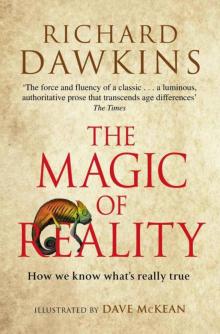 The Magic of Reality
The Magic of Reality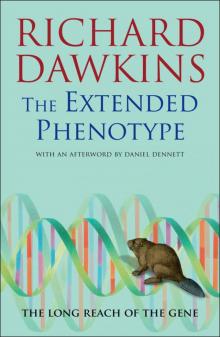 The Extended Phenotype
The Extended Phenotype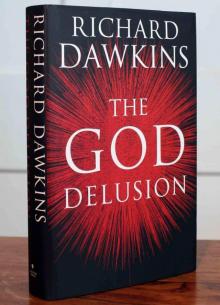 The God Delusion
The God Delusion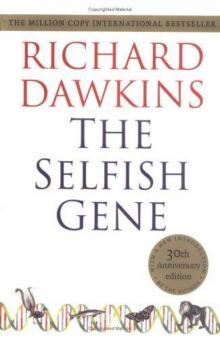 The Selfish Gene
The Selfish Gene The Blind Watchmaker
The Blind Watchmaker The Greatest Show on Earth
The Greatest Show on Earth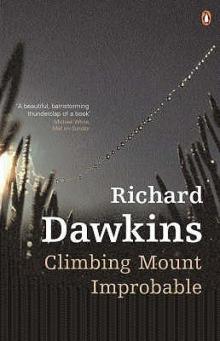 Climbing Mount Improbable
Climbing Mount Improbable Outgrowing God
Outgrowing God Brief Candle in the Dark
Brief Candle in the Dark The Greatest Show on Earth: The Evidence for Evolution
The Greatest Show on Earth: The Evidence for Evolution Science in the Soul
Science in the Soul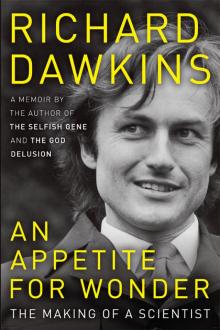 An Appetite for Wonder
An Appetite for Wonder